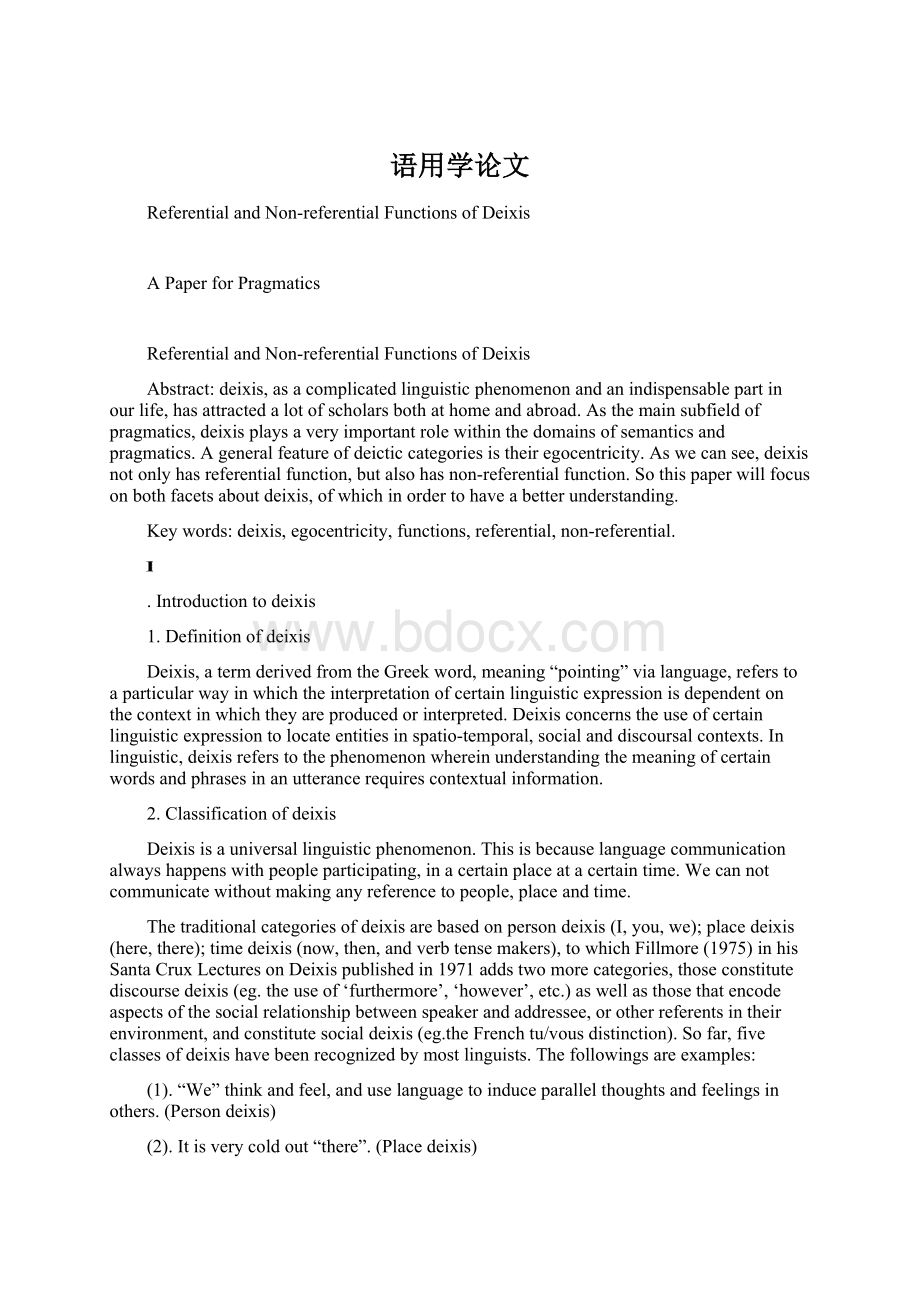 语用学论文Word文档格式.docx
语用学论文Word文档格式.docx
- 文档编号:18451522
- 上传时间:2022-12-16
- 格式:DOCX
- 页数:7
- 大小:21.76KB
语用学论文Word文档格式.docx
《语用学论文Word文档格式.docx》由会员分享,可在线阅读,更多相关《语用学论文Word文档格式.docx(7页珍藏版)》请在冰豆网上搜索。

.Introductiontodeixis
1.Definitionofdeixis
Deixis,atermderivedfromtheGreekword,meaning“pointing”vialanguage,referstoaparticularwayinwhichtheinterpretationofcertainlinguisticexpressionisdependentonthecontextinwhichtheyareproducedorinterpreted.Deixisconcernstheuseofcertainlinguisticexpressiontolocateentitiesinspatio-temporal,socialanddiscoursalcontexts.Inlinguistic,deixisreferstothephenomenonwhereinunderstandingthemeaningofcertainwordsandphrasesinanutterancerequirescontextualinformation.
2.Classificationofdeixis
Deixisisauniversallinguisticphenomenon.Thisisbecauselanguagecommunicationalwayshappenswithpeopleparticipating,inacertainplaceatacertaintime.Wecannotcommunicatewithoutmakinganyreferencetopeople,placeandtime.
Thetraditionalcategoriesofdeixisarebasedonpersondeixis(I,you,we);
placedeixis(here,there);
timedeixis(now,then,andverbtensemakers),towhichFillmore(1975)inhisSantaCruxLecturesonDeixispublishedin1971addstwomorecategories,thoseconstitutediscoursedeixis(eg.theuseof‘furthermore’,‘however’,etc.)aswellasthosethatencodeaspectsofthesocialrelationshipbetweenspeakerandaddressee,orotherreferentsintheirenvironment,andconstitutesocialdeixis(eg.theFrenchtu/vousdistinction).Sofar,fiveclassesofdeixishavebeenrecognizedbymostlinguists.Thefollowingsareexamples:
(1).“We”thinkandfeel,anduselanguagetoinduceparallelthoughtsandfeelingsinothers.(Persondeixis)
(2).Itisverycoldout“there”.(Placedeixis)
(3).WewillleaveforBeijing“tomorrow”.(Timedeixis)
(4).“Inotherwords”,weinterpretparticularinstancesoflanguagebyreferringthemtogeneralscheme.(Textdeixis)
(5).Whereareyouheading,LaoWang?
(Socialdeixis)
3.Egocentricityofdeixis
Deicticcentersaretypicallyassumedtobeasfollows.
(1).Thecentralpersonisthespeaker;
(2).Thecentraltimeisthetimeatwhichthespeakerproducestheutterance;
(3).Thecentralplaceisthespeaker’slocationatutterancetime;
(4).Thediscoursecenteristhepointwhichthespeakeriscurrentlyatintheproductionofhisutterance;
(5).Thesocialcenteristhespeaker’ssocialstatusandrank,towhichthestatusorrankofaddresseesorreferentsisrelative.(Levinson,1983:
64)
Deixisisclearlyaformofreferringthatistiedtothespeaker’scontext,withthemostbasicdistinctionbetweendeicticexpressionsbeing‘nearspeaker’versus‘awayfromspeaker’.InEnglish,the‘nearspeaker’,orproximalterms,are‘this’,‘here’,‘now’.The‘awayfromspeaker’,ordistalterms,are‘that’,‘there’,‘then’.
.Referentialfunctionofdeixis
Themostoutstandingfeatureofdeixisisthatitmaintainsthereferentialfunction.Sonextwe’regoingtoillustrateitsreferentialfunctionfromthefollowingaspects.
1.Persondeixis
Persondeixisconcernsitselfwiththegrammaticalpersonsinvolvedinanutterance,thosedirectlyinvolved(eg.thespeaker,theaddressee),thosenotdirectlyinvolved(eg.overhears–thosewhoheartheutterancebutwhoarenotbeingdirectlyaddressed),andthosementionedintheutterance.InEnglish,thedistinctionsaregenerallyindicatedbypronouns.Thefollowingexamplesshowhow.
Iamgoingtothemovies.
Wouldyouliketohavedinner?
Theytriedtohurtme,buthecametotherescue.
It’sknownthattheabovethreesentenceshavetheirrespectivemeaningshappeninginacertaincontext.Sothepronounshavetheirreferences.Wecansee“I”referstothespeaker;
“You”referstothelistener;
“They”and“He”refertopersonnothere.Sothespecialreferenceiswhatwecallreferentialfunctionofpersondeixis.Besides,afairlywell-knownexampleofasocialcontrastencodedwithinpersondeixisisthedistinctionbetweenformsusedforafamiliarversusanon-familiaraddresseeinsomelanguage.ThisisknownastheT/Vdistinction.Thechoiceofoneformwillcertainlycommunicatesomething(notdirectlysaid)aboutthespeaker’sviewofhisorherrelationshipwiththeaddressee.Inthosesocialcontextsindividualstypicallymarkdistinctionsbetweenthesocialstatusofthespeakerandaddressees.T/Vdistinctionalsoreflectsthereferentialfunctionofpersondeixis.
2.Placedeixis
Placedeixis,alsoknownasspacedeixis,concernsitselfwiththespatiallocationsrelevanttoanutterance.Similarlytopersondeixis,thelocationsmaybeeitherthoseofthespeakerandaddresseeorthoseofpersonsorobjectsbeingreferredto.ThemostsalientEnglishexamplesaretheadverbs“here”and“there”,andthedemonstratives“this”and“that”-althoughthosearefarfrombeingtheonlydeicticwords.
Someexamples:
Ienjoylivinginthiscity.
Hereiswherewewillplacethestatue.
Shewassittingoverthere.
Fromtheexamples,wecansee“thiscity”,“here”and“there”areallspecifiedwhichareinterpretedbybothspeakerandlistener.Listenercanunderstandwhatspeakersaidaboutthespecificplaceaccordingtotheircontextualinterpretation.Itisinterestingtonotethatwhile“here”and“there”areoftenusedtorefertolocationsneartoandfarfromthespeaker,respectively,“there”canalsorefertothelocationoftheaddressee,iftheyarenotinthesamelocationasthespeaker.So,while
Hereisagoodspot;
itistoosunnyoverthere.
exemplifiestheformerusage,
Howistheweatherthere?
isanexampleofthelatter.
So,wecanconcludethattheabovediscussionsarerelevanttoreferentialfunctionofplacedeixis.
3.Timedeixis
Timeortemporaldeixisconcernsitselfwiththevarioustimesinvolvedinandreferredtoinanutterance.Thisincludestimeadverbslike“now”,“then”,“soon”,andsoforth,andalsodifferenttenses.Agoodexampleisthewordtomorrow,whichdenotestheconsecutivenextdayaftereveryday.The“tomorrow”ofadaylastyearwasadifferentdaythanthe“tomorrow”ofadaynextweek.Timeadverbscanberelativetothetimewhenanutteranceismade(whatFillmorecallsthe“encodingtime”,orET)orwhentheutteranceisheard(Fillmore’s“decodingtime”,orDT).Whilethesearefrequentlythesametime,theycandiffer,asinthecaseofprerecordedbroadcastsofcorrespondence.Forexample,ifoneweretowrite
Itisrainingoutnow,butIhopewhenyoureadthisitwillbesunny.
theETandDTwouldbedifferent,withtheformerdeictictermconcerningETandthelattertheDT.
Tensesaregenerallyseparatedintoabsolute(deictic)andrelativetenses.So,forexample,simpleEnglishpasttenseisabsolute,suchasin
Hewent.
whilethepluperfectisrelativetosomeotherdeicticallyspecifiedtime,asin
Hehadgone.
Thereferentialtimedeixishasitsspecificmeaning,theaboveexamplesarethebestreflectionofreferentialfunctionoftimedeixis,whichrefertoacertaintimesomeactionstakeplace,andweshouldpayattentiontothisaspectofreferentialfunction.
4.Discoursedeixis
Discoursedeixis,alsoreferredtoastextdeixis,andreferstotheuseofexpressionswithinanutterancetorefertopartsofthediscoursethatcontainstheutterance-includingtheutteranceitself.Forexample,in
Thisisagreatstory.
“This”referstoanupcomingportionofthediscourse,andin
Thatwasanamazingday.
“That”referstoapriorportionofthediscourse.
5.Socialdeixis
Socialdeixisconcernssocialinformationthatisencodedwithinvariousexpressions,suchasrelativesocialstatusandfamiliarity.Twomajorformsofitaretheso-calledT-Vdistinctionsandhonorifics,whichwehavementionedbefore.
Theabovediscussionsareallconcernedwiththereferentialfunctionofdeixis.NextIwillmainlyintroduceyouthenon-referentialfunctionofdeixis.
.Non-referentialfunctionofdeixis
Deixisnotonlyhasitsreferentialfunction,butalsohasnon-referentialfunction,whichwedon’tattachgreatimportanceto.Thefollowingwillfocusonthisaspect.
Therearetwotypesofpersondeixisastothenon-referentialfunction:
oneistheuseofextensiveperson,theotherisreferenceincontext(anaphora&
cataphora).
(1).Non-referentialfunctionsingularfirstpersondeixis(I).
Thisfunctionreferstopersonpronounreplacingthenon-infinitivepronouninainformalcontext.The“I”notreferstothespecificspeakerorlistener,butreferstothewholeclassincludingspeakerandlistener;
“I”nomoremaintainsthereferentialmeaning,butthenon-referentialmeaning.Forexample,
Ifpeopledon’toffendme,Iwon’t;
ifpeopleoffend,Iwill.
Here,“I”referstotheChinaCommunistParty,notChairmanMao,inthissentence;
“I”don’trefertoaspecificspeaker,butreferstoeverymanintheCommunistParty.Thisisthenon-referentialfunctionofpersondeixis.
(2).Non-referentialfunctionofthepluralfirstpersondeixis(we).
First,let’sseeanexample.
Ibelieve,wewon’tletdowntheCommunistPartyandthewholecountry.
“we”hasthefriendlyrelatio
- 配套讲稿:
如PPT文件的首页显示word图标,表示该PPT已包含配套word讲稿。双击word图标可打开word文档。
- 特殊限制:
部分文档作品中含有的国旗、国徽等图片,仅作为作品整体效果示例展示,禁止商用。设计者仅对作品中独创性部分享有著作权。
- 关 键 词:
- 语用学 论文
 冰豆网所有资源均是用户自行上传分享,仅供网友学习交流,未经上传用户书面授权,请勿作他用。
冰豆网所有资源均是用户自行上传分享,仅供网友学习交流,未经上传用户书面授权,请勿作他用。


 《雷雨》中的蘩漪人物形象分析 1.docx
《雷雨》中的蘩漪人物形象分析 1.docx
